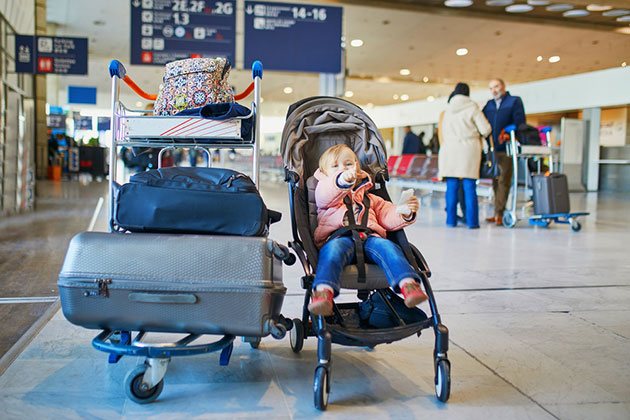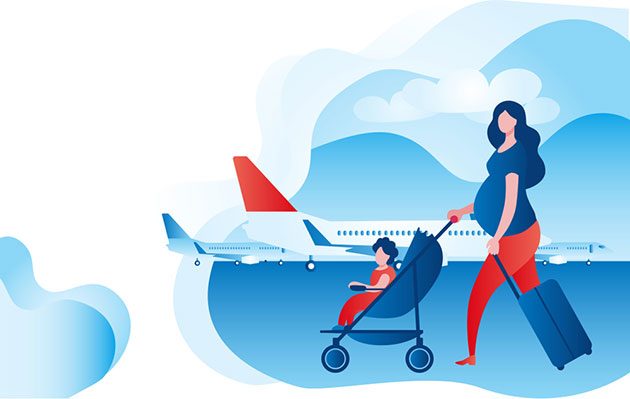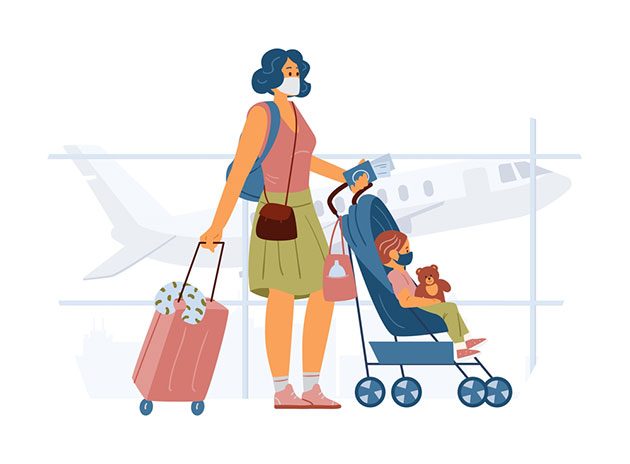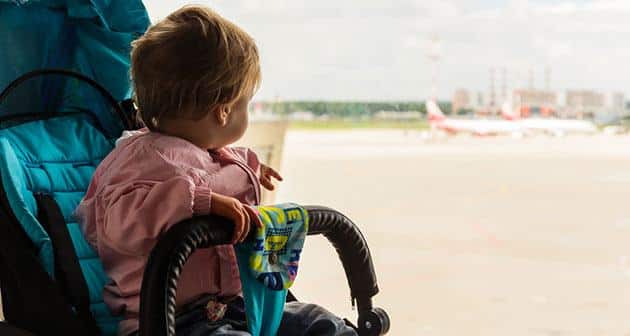Flying with kids looks like a never-ending packing list.
Airlines understand families’ needs and attempt to best accommodate both parents and children during the journeys. They allow parents to bring all necessary baby items - from diapers to strollers.
Not sure whether your strollers, seats or similar units count as a carry-on and how to fly with prams?
Here are the answers to the most common questions about strollers on airplanes!
More...
Table of Contents
- Flying with a stroller: Rules & regulations
- 1. Can you bring your own personal stroller on a plane?
- 2. What's the required size stroller suitable for aircraft?
- 3. What is the main purpose of gate-checking?
- 4. Bringing a pram as cabin baggage: Yes or no?
- 5. Can I take my umbrella baby stroller on a plane?
- 6. Can I travel with a car seat and a stroller?
- 7. How to check a stroller or a car seat?
- 8. How can I fully protect my stroller on a plane?
- Car seat and stroller policies: The exclusive 2022 list
- 1. Aeromexico
- 2. Air France
- 3. Alaska Airlines
- 4. American Airlines
- 5. British Airways
- 6. Air Canada
- 7. Delta Airlines
- 8. Hawaiian Airlines
- 9. Japan Airlines
- 10. JetBlue
- 11. KLM Royal Dutch Airlines
- 12. Lufthansa
- 13. Qantas Airlines
- 14. Singapore Airlines
- 15. Southwest
- 16. Spirit Airlines
- 17. Swiss Air
- 18. United Airlines
- 19. Virgin Atlantic
- 20. Qatar Airways
- 21. Norwegian
- Strollers on Airplanes: The Final Verdict
Flying with a stroller: Rules & regulations
1. Can you bring your own personal stroller on a plane?
Yes, you can. There are three main ways to take your baby capsule on a specific flight:
- When flying with an infant under two, numerous airlines allow you to bring a child seat and a stroller, free of charge, along with your normal baggage allowance.
The car seat and the pram go with the rest of your luggage in the aircraft hold. However, you must check the pram policies in advance, as they vary from one airline to another.
- If enough space is available, specific airlines allow you to bring a compact umbrella stroller free of charge. You will place it in the overhead lockers in the suitable cabin.
- Other particular airlines permit you to place the travel cot on board in place of your cabin baggage, but only if your stroller meets the official carry-on luggage size requirements.
2. What's the required size stroller suitable for aircraft?

Conventionally, flying with a baby capsule must be a fully collapsible stroller.
However, numerous airlines permit you to use a specific travel system - a stroller frame and an infant car seat in combination.
Let’s take American Airlines
as an instance. According to their pushchair policy, the stroller must meet the following requirements to count as a carry-on:
- It must be smaller than 22 x 14 x 9 inches (including handles and wheels)
- The stroller must fit in the carry-on sizer at the check-in counter
If customers bring both the pram and the seat, they can check only one baby system for free. And strollers over 20 pounds must be checked at the ticket counter.
3. What is the main purpose of gate-checking?
The travel cot usually stays with you until boarding, when it's time for a gate check. But, what's the goal of the pushchair gate checking, and where do the gate-checked prams go?
Gate-checked means the carrycot contains a specific tag with a corresponding destination tag at the check-in gate. It permits you to use the stroller at the airport freely and take it through the boarding gate.
When checked at the gate, the airport control requests that you collapse the stroller and the staff load it into the plane with the rest of your luggage.
But, if it's a compact cabin-sized stroller, small enough to meet the cabin requirements, you can bring it into the cabin.
The main trick here is the airline policy and whether the flight is full. The rule also tackles the umbrella-type collapsible stroller.
4. Bringing a pram as cabin baggage: Yes or no?
Yes, if your pushchair meets all official requirements (more info in the list below). It must be of the proper size limit to fit the cabin baggage. This best applies to a smaller pram or baggy. Otherwise, you won't be able to take a carrycot into the cabin.
On the other hand, certain airlines permit you to bring a collapsible stroller to your additional hand baggage allowance free of charge.
5. Can I take my umbrella baby stroller on a plane?
Yes, you can, if there is enough space in the cabin. But, you must check the airline pushchair policies.
For example, KLM Airlines states that your stroller must be 6 x 12 x 39 inches to take it into the cabin if there’s enough room. Otherwise, the staff will place it on hold with no charge.
If you have a bigger pram, you need to check it at the ticket counter. Also, you will take the collapsible stroller in addition to your hand baggage again free of charge.
6. Can I travel with a car seat and a stroller?
Yes, you can. If you travel with an infant or child under two years old, numerous airlines permit you to bring both the stroller and the car seat free of charge, in addition to the normal baggage allowance.
As the car seat and the pushchair go in the hold, it would be best to protect the complete child restraint system with either padding, a lighter bag and diapers or nappies, or a padded bag.
7. How to check a stroller or a car seat?
Where can you check our child restraint system? There are two options:
- At the gate
- At the curbside/ airport check-in counter (ticket counter)
When checked at the gate, the checking procedure is pretty simple. The gate staff or the flight attendant will give you a label to securely attach to the car seat or pushchair. It would be best to ask the team for the title as soon as you arrive at the gate, regardless of the checking time. The members will easily find your luggage and return the items to you quickly.
There won't be delays or further complications with the items, staff, or flight. Gate-checked strollers will be placed in the cargo hold during the flight and returned to the owners upon arrival.
Checking the stroller or the car seat at the ticket counter is also fast and straightforward. It's a similar process to checking any other baggage. You notify the personnel that you want a car seat or pram checked, and you'll get a luggage tag to attach to the checked restraint system.
Regardless of the checking spot, you must remove the attached car seat or stroller accessories, such as cup holders, toys, and similar units.
It would be valuable to secure all straps. And, if you're not using a carry-on bag, the process reduces the chance of possible damage or something getting caught.
8. How can I fully protect my stroller on a plane?

You can testify countless times how airport baggage handlers recklessly throw around and treat the buggies, pushchairs, travel strollers, and similar children restraint systems. If you don't want your stroller or car seat harmed, you should protect them well.
One way is to use a suitable stroller bag. Stroller bags are valuable since you can place multiple items inside and "wrap" your strollers and car seats. They will keep a blanket, nappies, diapers, toys, etc. You will also get a bit of additional baggage.
When traveling with a baby capsule, check it at the gate if possible. There are more people around, noticing that the travel system is delicate and needs special attention.
Padded stroller bags are better than regular bags as they are more extensive. Therefore, it would be better to use such products. But, unfortunately, you cannot cover all strollers fully with the nappies or pads.
On the other hand, a non-padded stroller bag isn't reliable since it offers little protection. However, it keeps your travel cot clean and all parts together.
If you don't plan on using it frequently, you don't need to buy it. You can always ask your friends to borrow one or search for other similar units to help you with airport control and transportation. But, it's always more convenient to have your pushchair bag.
Car seat and stroller policies: The exclusive 2022 list
1. Aeromexico
Allowance in the cabin overhead compartment: N/A
Stroller policy: Adults traveling with infants are allowed a piece of baggage and two extra units (bassinet, diaper bag, stroller).
The items should not exceed 50 pounds (23 kilograms) and the maximum linear proportions of 45 inches (115 centimeters).
2. Air France
Allowance in the cabin overhead compartment: YES
Stroller policy: Passengers can travel with an infant-carrying seat and a compact folding stroller in the hold for no additional fee.
In addition, the airline accepts only specific pushchairs in the cabin if there's enough space available.
Regarding a small foldable stroller, the proportions mustn’t exceed the following digits: 5.9 x 11.8 x 39.4 inches (15 x 30 x 100 centimeters).
Other foldable stroller types include the following policies:
- They replace the regular free baggage allowance (hand allowance for infants).
- Their proportions mustn’t exceed 21 x 13 x inches (55 x 35 x 25 centimeters).
- Passengers must pack them into an infant carry-on case to cover them completely.
It's crucial to note that some airports will NOT permit you access to prams inside the boarding areas due to safety and security reasons.
Remember that the small travel cot policy applies for international flights, with exceptions to specific flights.
3. Alaska Airlines
Allowance in the cabin overhead compartment: YES
Stroller policy: Passengers are permitted to bring one child restraint system and pram free of charge as checked baggage. You can either wait until you reach the gate area or check the units with other luggage.
Bringing the pushchair in is possible without counting towards your carry-on limits. However, the premise is that there must be available space. It's guaranteed only with the purchase of a ticket for your infant.
4. American Airlines
Allowance in the cabin overhead compartment: N/A
Stroller policy: Each passenger is allowed one car seat and one pram checked at the gate without extra costs.
All strollers weighing more than 20 pounds ( nine kilograms) must pass the ticket counter check.
All other travel cots must be checked at the gate before boarding.
You can check only ONE item at the gate if you have one car seat and a pram.
Allowance in the cabin overhead compartment: Yes
Stroller policy: Passengers with a small, collapsible, compact foldable lightweight stroller/pushchair are qualified to take the units to the aircraft doors and later collect them at most airports. When fully loaded, the strollers' proportions must be 46 x 15 x 15 inches (117 x 38 x 38 centimeters).
The flight attendant is at the boarding gate, ready to place your pram into the hold and return them to you at the aircraft door.
Specific travel cots (Yo-Yo Zen and similar pushchairs) within the upper limit of the hand-checked baggage allowance are not allowed on top of your cabin bag. But, you can take it on board in place of the cabin bag.
All larger children's strollers (double stroller, multi-piece prams) and similar child restraint systems must pass the departure gate. Still, you must pick up the larger units at the baggage carousel in the baggage hall upon arrival.
6. Air Canada

Allowance in the cabin overhead compartment: N/A
Stroller policy: Passengers can bring one stroller for each child they're traveling. It counts on top of the carry-on and checked baggage allowance aside from your destination. However, Air Canada strongly urges you to use small collapsible umbrella strollers.
Small travel cots not exceeding 10 x 36 inches (25.5 x 92 cm) in diameter and length can be checked free of charge at the boarding gate/baggage counter. After passing the baggage counter, the pram is delivered to the arrivals baggage hall at the final destination. The stroller is offered to you at the aircraft door when accepted at the boarding gate.
Bulkier pushchairs/strollers are checked only at the baggage counter. The gate facilities are not designed to accommodate such heavy units. Additional baggage fees do not apply. However, more oversized baby items are also subject to space and proportion limits. Thus, there is a risk that the aircraft cannot accommodate the items correctly.
Allowance in the cabin overhead compartment: N/A
Stroller policy: You can check your pushchairs/strollers at the ticket counter, curb, or gate. The airline won't count car seats or strollers as a part of the standard baggage. You can check the units for free.
Besides the carry-on allowance, you can bring other booster seats, infant car seats, or bassinets on the airplane as additional free products. However, you must pay attention to the carry-on size restrictions.
If you're carrying an infant car seat or a bassinet, ensure the child seat restraints your kid correctly. It must be adequately secured on the plane seat with a seat belt.
8. Hawaiian Airlines
Allowance in the cabin overhead compartment: Yes
Stroller policy: Pushchairs can be checked for free. However, your prams must be checked if:
- They weigh more than 50 pounds
- They are non-collapsible strollers
9. Japan Airlines
Allowance in the cabin overhead compartment: Yes
Stroller policy: At specific airports, you will freely use the baby capsules. However, it would be beneficial to inquire the personnel about additional possibilities when you check-in.
Space on board always has certain restrictions. The policy strongly urges you to check in the prams.
The personnel will return the strollers to you as soon as possible.
You can freely use the free baby stroller service until your pram arrives at different airports.
10. JetBlue
Allowance in the cabin overhead compartment: N/A
Stroller policy: When traveling with the infant on the adult's lap, you can bring multiple items for free - a car seat, a pram, or a diaper bag.
Children traveling for free won't have a checked luggage allowance. You should pack everything you need inside the child's diaper bag (diapers, nappies, toys, bottles, etc.)
11. KLM Royal Dutch Airlines
Allowance in the cabin overhead compartment: Yes
Stroller policy: If space allows, you can bring your umbrella strollers to the cabin. They must be 6 x 12 x 39 inches (15 x 30 x 100 cm). When there's not enough room, the staff will take it into the hold at no extra cost.
You can stroll your baby to the departure gate if the facilities allow it. You must hand the buggy for loading. Cover it in a protective bag, with no extra items.
12. Lufthansa
Allowance in the cabin overhead compartment: Yes
Stroller policy: Car seats, buggies, and prams are allowed as carry-on baggage free of charge.
Keep the restraint system with you, and take your buggy or pram straight to the flight.
Take one compact and foldable buggy on board with you as carry-on baggage, or two, for the First or Business Class. The dimensions must be 55 x 40 x 23 cm.
All toys, clothes, diapers, nappies, and other baby necessities are part of hand luggage.
13. Qantas Airlines
Allowance in the cabin overhead compartment: N/A
Stroller policy: Most Australian airports have available prams once your stroller is checked. The personnel will:
- Assist you at the boarding gate
- Collect your pushchairs
- Help with the additional boarding procedures.
14. Singapore Airlines
Allowance in the cabin overhead compartment: Yes
Stroller policy: You can bring any small, foldable, and fully collapsible stroller if:
- The travel cot meets the standard cabin bag proportions - a maximum weight limit of seven kilograms, and the dimensions should not exceed 115 cm.
- You must pack the stroller inside the proper carrying bag before boarding. You cannot use the pram in the cabin at all times.
- A pushchair counts as a cabin baggage allowance for your traveling class.
If there isn't enough room in the overhead baggage compartment, foldable strollers must be checked. All other prams not meeting the prior requirements will be limited. But, they won't be counted as a part of the checked bag allowance.
15. Southwest
Allowance in the cabin overhead compartment: N/A
Stroller policy: Parents can check a stroller and a car seat without additional costs. Adults will fit pushchairs, CRS’s, or car seats per each child as an addition to the free -checked baggage allowance.
The car seats, prams, and car seat allowance applies to all stroller types - jogging stroller, umbrella, full size, etc. Passengers should check the products at the ticket counter, boarding gate, or curb.
Southwest Airlines won't assume liability for damaged restraint systems. You can purchase a reusable child's car seat/stroller bag at the Southwest Airlines ticket counter for $17, with dimensions of 40 x 20.5 x 12.5 inches.
16. Spirit Airlines
Allowance in the cabin overhead compartment: N/A
Stroller policy: You can check one stroller and car seat per kid at the ticket counter or gate. When traveling with two kiddos, you can check the double stroller.
You can bring the FAA-approved car seat or the FAA-approved CARES if you purchase a separate seat for your child.
Remember that not all FAA-approved car seats fit all Spirit plane seats.
Also, not all seats will have inflatable seat belts. And, they won’t be secured in the exit seat or the row before or after the exit seat.
17. Swiss Air
Allowance in the cabin overhead compartment: Yes
Stroller policy: You may take your pram or pushchair free of charge. You may also take the so-called "pocket buggie" on the board as a part of the free hand baggage allowance. They must be packed correctly and not recognizable as pushchairs.
At most airports, you can use strollers before boarding. The staff will return them to you upon arrival. Contact the team if this is not the case, and wait a few minutes if delayed in delivery. There are specific airports with no direct delivery.
18. United Airlines

Allowance in the cabin overhead compartment: Yes
Stroller policy: You can bring the Government-approved child seat, diaper bag, breastmilk, pump, and personal items in the carry bag.
You can bring a compact folding stroller with the following proportions:
- 9 x 14 x 22 inches or
- 9 x 10 x 17 inches.
The airline accepts one stroller and one folding wagon free of charge, in addition to the FAA-approved car seat.
Non-collapsible prams or non-folding wagons won't be checked at the gate. Instead, inquire about an official representative to guide you through the procedure.
The airline doesn't reserve a space for FAA seats unless you purchase a ticket for it. After this is available, passengers can use adjacent unused seats and secure the child safety seat.
19. Virgin Atlantic
Allowance in the cabin overhead compartment: Yes
Stroller policy: You can take a fully foldable stroller and the FAA-approved car safety seat on top of the free checked baggage.
The prams will be checked and placed in the hold, then returned to you after arrival.
You must pick them up at the baggage hall at some destinations due to specific restrictions. Or, you can use the following buggies as your carry-on baggage:
- BabyZen YoYo
- Silver CrossJet
- Britax Holiday
- gb Pocket
20. Qatar Airways
Allowance in the cabin overhead compartment: Yes
Stroller policy: You can place a carrycot, an infant's carrying basket, a stroller, or a seat in the cabin with no extra charge. However, the stroller must be folded and compact to meet the overall dimensions.
If the stroller is handled at the check-in counter, you must check it for manual loading.
You must wrap the pram in cellophane, cover or sponge it, and remove the accessories to reduce weight.
Also, put your contact data on the stroller to avoid complications. Find the staff and regulate where you will receive the pushchair upon arrival.
21. Norwegian
Allowance in the cabin overhead compartment: Yes
Stroller policy: For infants under two and children up to eleven years, one seat and stroller are included in the ticket. They’re free of charge, with the corresponding amount of checked baggage.
The dimensions must not exceed 250 x 79 x 112 cm and more than 74 kg.
Strollers on Airplanes: The Final Verdict
There are limitless restrictions and rules when traveling with car seats and strollers. Ensure you examine them thoroughly to know exactly where you can put them and avoid delays.
Also, check your beginning and final place of the car seats and strollers (baggage claim carousel, landing, or oversized luggage counter.)
Put contact info if something goes wrong for quick problem-solving. And, always protect your strollers and car seats from damage.
